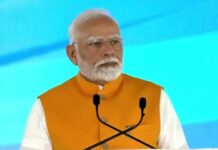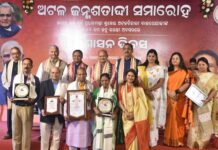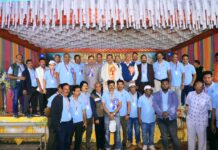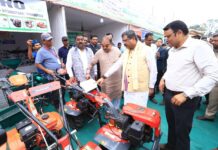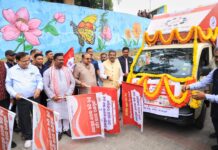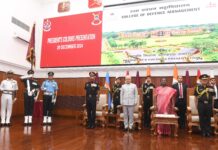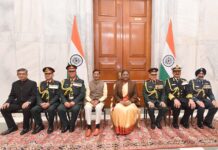By Our Correspondent
KOLKATA/BHUBANESWAR: The Union Minister for Jal Shakti, Shri Gajendra Singh Shekhawat today chaired a Regional Conference of six (6) States at Kolkata to review the progress made under Jal Jeevan Mission and Swachh Bharat Mission-Grameen by the participating States. The Conference was attended by Shri Prahlad Singh Patel, Minister of State for Jal Shakti and Food Processing Industries, and Shri Pulak Roy, Minister-in-charge Public Health Engineering (PHE) and Panchayat & Rural Development, Government of West Bengal. Senior officers from Bihar, Chhattisgarh, Jharkhand, Mizoram, Odisha and West Bengal shared their concerns while implementing ‘Har Ghar Jal’ and ‘Swachh Bharat Mission(Grameen) programme.
The Union Minister, in his inaugural address said, “When Jal Jeevan Mission was launched by the Prime Minister on 15th August 2019, only 17% rural households had access to tap water connection. Despite disruptions and lockdown in the last 2½ years, we have managed to provide more than 5.91 Crore tap water connections and 47.39% of households in villages are benefitting from clean drinking water. Shri Shekhawat asserted “there is no dearth of funds for implementation of two-flagship programmes of the government, as for the year 2022-23, Rs 14,449 Crore has been allocated as Central grant to the 6 participating States for ensuring 100% tap water connectivity and sustaining ODF & solid and liquid waste management in villages,”. He exhorted that ‘Har Ghar Jal’ should be a society driven and not engineer-driven programme. The States/ UTs must give preference to single-village gravity-based schemes as these are affordable, sustainable and economical in operation and maintenance in the long-run. The cost component should be thoroughly checked as we formulate detailed project reports (DPRs) for schemes under Jal Jeevan Mission.”
The Union Minister added, “The nation takes pride by saying that all districts in India declared themselves open defecation free (ODF) on 2nd October 2019, much ahead of the target deadline set under Sustainable Development Goal (SDG) 6.” He further exhorted the States which are on the banks of river Ganga to ensure that not a single drop of untreated water flows into river Ganga. If required funds from various schemes may be dovetailed for carrying out SLWM activities in these villages.
“Jal Jeevan Mission follows the philosophy laid down by the Prime Minister of ensuring ‘no one is left out’. Village Action Plan is drafted at the Gram Sabha meeting where people from all walks of life participate and draw a road map for the next 5-years,” said the Minister of State for Jal Shakti, Shri Prahlad Singh Patel.
“Prime Minister launched Jal Jeevan Mission in 2019 with the aim to provide tap water connection in every rural home. There is need to focus on community involvement in planning and monitoring. Village Water and Sanitation Committee (VWSC) and surveillance committee members must be trained and local people should be skilled to carry out minor repair and maintenance of water supply infrastructure in the long run. Water testing laboratories at district-level need to be strengthened so as to ensure the quality of water supplied in every household and public institution. It is very essential that we ensure the quality of water and the pipe through which water flows,” said the Minister of State for Jal Shakti and Food Processing Industries, Shri Prahlad Singh Patel.
Under 15th Finance Commission a total of Rs 27,908 Crore is allocated for Rural Local Bodies/ Panchayati Raj Institutions (RLBs/ PRIs) for the year 2022-23. There is an assured allocation of Rs 1,42,084 Crore for next five-years i.e. upto 2025-26. For the participating States, Rs 6,856 Crore is allocated as tied grant to carry out water and sanitation related activities for the year 2022-23.
Reaffirming its commitment towards public health and well-being of the people living in rural areas, in the Union Budget 2022, fund allocation for JJM has been increased from Rs 45,000 Crore in 2021-22 to Rs 60,000 Crore in 2022-23. For SBM(G), Rs 7,192 Crore has been allocated in the budget for the year 2022-23.
For the year 2022-23 under JJM, Rs 13,105 Crore has been tentatively allocated by the Centre for these 6 States. (Bihar – Rs 2,699 Crore, Chhattisgarh – Rs 1,308 Crore, Jharkhand – Rs 1,643 Crore, Mizoram – Rs 201 Crore, Odisha – Rs 2,036 Crore and West Bengal – Rs 5,218 Crore). Under SBM(G), Rs 1,344.71 Crore has been tentatively allocated for the said States. (Bihar – Rs 499.50 Crore, Chhattisgarh – Rs 149.88 Crore, Jharkhand – Rs 109.19 Crore, Mizoram – Rs 10.74 Crore, Odisha – Rs 213.71 and West Bengal – Rs 361.69 Crore).
SBM(G) Phase-II was approved in February, 2020 with a total outlay of Rs 1,40,881 Crore to focus on sustainability of ODF status and Solid and Liquid Waste Management (SLWM). SBM(G) Phase II is a novel model of convergence between different verticals of financing under various Central and State governments. Apart from budgetary allocations by Department of Drinking Water and Sanitation (DDWS) and corresponding State share, remaining funds are being dovetailed from 15th Finance Commission tied-grants to Rural Local Bodies, MGNREGS, CSR funds and revenue generation models, etc., particularly for Solid and Liquid Waste Management (SLWM). Phase II of SBM(G) has seen a solid start with nearly 65 lakh household benefitting from Individual Household Latrines(IHHL). Over 1.18 lakh Community toilets were built and more than 43,000 villages declared themselves ODF Plus in the country. Over 50,000 villages have already been covered with solid waste management (SWM) arrangements and over 25,000 villages have achieved liquid waste management (LWM) arrangements.
In the participating States, number of IHHL’s and Community Sanitary Complexes (CSC’s) constructed during SBM-G Phase II is over 19 lakhs and over 15,000 respectively and over 4,000 villages are declared as ODF Plus.
Since the announcement of Jal Jeevan Mission on 15thAugust 2019, significant progress has been made across the country. Today, more than 9.15 Crore rural households have provision of tap water connection. So far under the programme, 4.71 lakh Village Water and Sanitation Committees (VWSC) have been constituted and 3.87 Village Action Plans (VAPs) have been developed. More than 9.26 lakh women in the Country have received training on how to use the Field Test Kits (FTKs) to enable checking the quality of water provided. These women are part of the 5-member surveillance committee set up in every village. There are a total of 1.78 lakh villages spread across 6 States participating in the conference, of these 42,385 villages have been provided 100% tap water coverage.
Following Prime Minister Shri Narendra Modi’s vision of “Sabka Saath, Sabka Vikas, Sabka Vishwas aur Sabka Prayas”, 101 districts, 1,160 blocks, 67,729 gram panchayats and 1,40,111 villages have become ‘Har Ghar Jal’ in the country. Three States – Goa, Telangana and Haryana and three UTs – A&N Islands, D&N Haveli & Daman & Diu and Puducherry have provided 100% tap water coverage.
While setting the agenda Smt. Vini Mahajan, Secretary, DDWS in her opening remarks said, “These are two very ambitious programmes of the government which are looking at universal coverage in providing tap water connectivity and access to toilets for all people living in rural India. We are now halfway through, and now it is time for stock taking to address the issues faced by the States/ UTs in programme implementation. World has recognized water and sanitation as the basic need. We work in close partnership with States/ UTs and Gram Panchayats to ensure clean water and ODF Plus villages by 2024. We are hopeful that the issues raised during the deliberations will be addressed. There is assured support of funds and technical assistance from the Centre.”
The Secretary added, “Regional conferences are organized pan India clubbing States and UTs to deliberate on the progress made under JJM and SBM(G). This is a crucial year for the programme as we have reached mid-way, constant monitoring is required as we enter the next financial year. It is essential that the Annual Action Plans are prepared meticulously so that our achievements meet our annual targets. This conference is an opportunity for firming up our annual plans for 2022-23, apart from the discussions on implementation challenges. SBM(G) and JJM are two transformational missions which provide ‘ease of living’ especially to women and young girls. States must ensure that provision for adequate state share under JJM is made in States’ budget for 2022-23.”
Shri Arun Baroka, Additional Secretary & Mission Director (JJM and SBM(G)) while making the detailed presentation on the status of both JJM and SBM(G) at the conference emphasized “The States should think beyond ‘Har Ghar Jal’ as source strengthening and sustainability is of prime importance in long-tern supply of water. There is need to set up grievance redressal mechanism where concerns of people are heard and addressed in a timely manner. Operation & Maintenance of water supply schemes have to be handed over to Panchayats and the community who will be the ultimate custodian of in-village water supply infrastructure. All VAPs must include greywater management so that ground water is recharged and treated water is reused.”
Speaking on SBM(G), AS & MD desired, “the States/ UTs need to carry out 2nd round of ODF verification to ensure sanitation sustainability to avoid any slippages. Behaviour change activities under the programme must continue as the work does not end with building toilets. There is need to ensure that the toilets are used by all and at all times.”
There are a total of 117 Aspirational districts in the country while 58 of these districts fall in the participating States. So far, under the programme, in all Aspirational districts in participating States, the coverage ranges between 18% to 89%. There is a need to pick up speed so that people living in the region soon get access to clean drinking water.
‘Har Ghar Jal’ envisages bottom up approach in planning and implementation of rural water supply schemes. So far under the programme, in these participating States 95,087 Village Water & Sanitation Committees (VWSCs) have been constituted and 73,591 Village Action Plans (VAPs) have been developed. More than 1.33 lakh women in the villages have been trained on how to use the Field Test Kits (FTKs) to carry out Water Quality Monitoring & Surveillance (WQM&S) activities. These women are part of the 5-women surveillance committee formed in every village to test the water quality at the sources & delivery points and report in case any contamination is found so that immediate remedial action can be initiated.
Subject matter experts and senior government officials held technical sessions on role of rural local bodies in ensuring water and sanitation activities in convergence with 15th Finance Commission funds. A specific session was dedicated on grey water management in the conference. A special session was organized on quality aspects in implementation of Jal Jeevan Mission.


